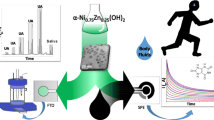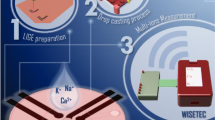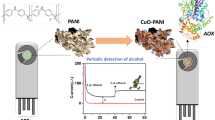Abstract
For the first time the development of an electrochemical method for simultaneous quantification of Zn2+ and uric acid (UA) in sweat is described using an electrochemically treated 3D-printed working electrode. Sweat analysis can provide important information about metabolites that are valuable indicators of biological processes. Improved performance of the 3D-printed electrode was achieved after electrochemical treatment of its surface in an alkaline medium. This treatment promotes the PLA removal (insulating layer) and exposes carbon black (CB) conductive sites. The pH and the square-wave anodic stripping voltammetry technique were carefully adjusted to optimize the method. The peaks for Zn2+ and UA were well-defined at around − 1.1 V and + 0.45 V (vs. CB/PLA pseudo-reference), respectively, using the treated surface under optimized conditions. The calibration curve showed a linear range of 1 to 70 µg L−1 and 1 to 70 µmol L−1 for Zn2+ and UA, respectively. Relative standard deviation values were estimated as 4.8% (n = 10, 30 µg L−1) and 6.1% (n = 10, 30 µmol L−1) for Zn2+ and UA, respectively. The detection limits for Zn2+ and UA were 0.10 µg L−1 and 0.28 µmol L−1, respectively. Both species were determined simultaneously in real sweat samples, and the achieved recovery percentages were between 95 and 106% for Zn2+ and 82 and 108% for UA.
Graphical abstract








Similar content being viewed by others
References
Cardoso RM, Kalinke C, Rocha RG et al (2020) Additive-manufactured (3D-printed) electrochemical sensors: a critical review. Anal Chim Acta 1118:73–91. https://doi.org/10.1016/j.aca.2020.03.028
Carrasco-Correa EJ, Simó-Alfonso EF, Herrero-Martínez JM, Miró M (2021) The emerging role of 3D printing in the fabrication of detection systems. TrAC Trends Anal Chem 136:116177. https://doi.org/10.1016/j.trac.2020.116177
Ambrosi A, Pumera M (2016) 3D-printing technologies for electrochemical applications. Chem Soc Rev 45:2740–2755. https://doi.org/10.1039/c5cs00714c
Ngo TD, Kashani A, Imbalzano G et al (2018) Additive manufacturing (3D printing): a review of materials, methods, applications and challenges. Compos Part B Eng 143:172–196. https://doi.org/10.1016/j.compositesb.2018.02.012
Hamzah HH, Shafiee SA, Abdalla A, Patel BA (2018) 3D printable conductive materials for the fabrication of electrochemical sensors: a mini review. Electrochem Commun 96:27–31. https://doi.org/10.1016/j.elecom.2018.09.006
Singamneni S, Warnakula A, Smith DA, Le Guen MJ (2019) Biopolymer alternatives in pellet form for 3D printing by extrusion. 3D Print Addit Manuf 6:217–226. https://doi.org/10.1089/3dp.2018.0152
Kalinke C, Neumsteir NV, Aparecido GDO et al (2020) Comparison of activation processes for 3D printed PLA-graphene electrodes: electrochemical properties and application for sensing of dopamine. Analyst 145:1207–1218. https://doi.org/10.1039/c9an01926j
Cardoso RM, Rocha DP, Rocha RG et al (2020) 3D-printing pen versus desktop 3D-printers: fabrication of carbon black/polylactic acid electrodes for single-drop detection of 2,4,6-trinitrotoluene. Anal Chim Acta 1132:10–19. https://doi.org/10.1016/j.aca.2020.07.034
Rocha DP, Ataide VN, de Siervo A, et al (2021) Reagentless and sub-minute laser-scribing treatment to produce enhanced disposable electrochemical sensors via additive manufacture. Chem Eng J 130594. https://doi.org/10.1016/j.cej.2021.130594
Wirth DM, Sheaff MJ, Waldman JV et al (2019) Electrolysis activation of fused-filament-fabrication 3D-printed electrodes for electrochemical and spectroelectrochemical analysis. Anal Chem 91:5553–5557. https://doi.org/10.1021/acs.analchem.9b01331
Redondo E, Muñoz J, Pumera M (2021) Green activation using reducing agents of carbon-based 3D printed electrodes: turning good electrodes to great. Carbon N Y 175:413–419. https://doi.org/10.1016/j.carbon.2021.01.107
Browne MP, Novotný F, Sofer Z, Pumera M (2018) 3D printed graphene electrodes’ electrochemical activation. ACS Appl Mater Interfaces 10:40294–40301. https://doi.org/10.1021/acsami.8b14701
Silva VAOP, Fernandes-Junior WS, Rocha DP et al (2020) 3D-printed reduced graphene oxide/polylactic acid electrodes: a new prototyped platform for sensing and biosensing applications. Biosens Bioelectron 170:112684. https://doi.org/10.1016/j.bios.2020.112684
Cardoso RM, Silva PRL, Lima AP et al (2020) 3D-printed graphene/polylactic acid electrode for bioanalysis: biosensing of glucose and simultaneous determination of uric acid and nitrite in biological fluids. Sens Actuators, B Chem 307:127621. https://doi.org/10.1016/j.snb.2019.127621
Richter EM, Rocha DP, Cardoso RM et al (2019) Complete additively manufactured (3D-printed) electrochemical sensing platform. Anal Chem 91:12844–12851. https://doi.org/10.1021/acs.analchem.9b02573
Rocha DP, Squissato AL, da Silva SM et al (2020) Improved electrochemical detection of metals in biological samples using 3D-printed electrode: chemical/electrochemical treatment exposes carbon-black conductive sites. Electrochim Acta 335:135688. https://doi.org/10.1016/j.electacta.2020.135688
Rocha DP, Foster CW, Munoz RAA et al (2020) Trace manganese detection via differential pulse cathodic stripping voltammetry using disposable electrodes: additively manufactured nanographite electrochemical sensing platforms. Analyst 145:3424–3430. https://doi.org/10.1039/d0an00018c
Pirovano P, Dorrian M, Shinde A et al (2020) A wearable sensor for the detection of sodium and potassium in human sweat during exercise. Talanta 219:121145. https://doi.org/10.1016/j.talanta.2020.121145
Kim T, Yi Q, Hoang E, Esfandyarpour R (2021) A 3D printed wearable bioelectronic patch for multi-sensing and in situ sweat electrolyte monitoring. Adv Mater Technol 6:1–11. https://doi.org/10.1002/admt.202001021
Dias AA, Chagas CLS, Silva-Neto HDA et al (2019) Environmentally friendly manufacturing of flexible graphite electrodes for a wearable device monitoring zinc in sweat. ACS Appl Mater Interfaces 11:39484–39492. https://doi.org/10.1021/acsami.9b12797
Katseli V, Economou A, Kokkinos C (2021) Smartphone-addressable 3D-printed electrochemical ring for nonenzymatic self-monitoring of glucose in human sweat. Anal Chem 93:3331–3336. https://doi.org/10.1021/acs.analchem.0c05057
Nah JS, Barman SC, Zahed MA et al (2021) A wearable microfluidics-integrated impedimetric immunosensor based on Ti3C2Tx MXene incorporated laser-burned graphene for noninvasive sweat cortisol detection. Sens Actuators, B Chem 329:129206. https://doi.org/10.1016/j.snb.2020.129206
Ardalan S, Hosseinifard M, Vosough M, Golmohammadi H (2020) Towards smart personalized perspiration analysis: an IoT-integrated cellulose-based microfluidic wearable patch for smartphone fluorimetric multi-sensing of sweat biomarkers. Biosens Bioelectron 168:112450. https://doi.org/10.1016/j.bios.2020.112450
Lee HB, Meeseepong M, Trung TQ et al (2020) A wearable lab-on-a-patch platform with stretchable nanostructured biosensor for non-invasive immunodetection of biomarker in sweat. Biosens Bioelectron 156:112133. https://doi.org/10.1016/j.bios.2020.112133
Emaminejad S, Gao W, Wu E et al (2017) Autonomous sweat extraction and analysis applied to cystic fibrosis and glucose monitoring using a fully integrated wearable platform. Proc Natl Acad Sci 114:4625–4630
Córdova A, Navas FJ (1998) Effect of training on zinc metabolism: changes in serum and sweat zinc concentrations in sportsmen. Ann Nutr Metab 42:274–282. https://doi.org/10.1159/000012744
Yan Q, Zhi N, Yang L et al (2020) A highly sensitive uric acid electrochemical biosensor based on a nano-cube cuprous oxide/ferrocene/uricase modified glassy carbon electrode. Sci Rep 10:1–10. https://doi.org/10.1038/s41598-020-67394-8
Yang Y, Song Y, Bo X et al (2020) A laser-engraved wearable sensor for sensitive detection of uric acid and tyrosine in sweat. Nat Biotechnol 38:217–224. https://doi.org/10.1038/s41587-019-0321-x
Honeychurch KC, Rymansaib Z, Iravani P (2018) Anodic stripping voltammetric determination of zinc at a 3-D printed carbon nanofiber–graphite–polystyrene electrode using a carbon pseudo-reference electrode. Sens Actuators, B Chem 267:476–482. https://doi.org/10.1016/j.snb.2018.04.054
De SAPR, Lima AS, Salles MO et al (2010) The use of a gold disc microelectrode for the determination of copper in human sweat. Talanta 83:167–170. https://doi.org/10.1016/j.talanta.2010.09.001
Manzanares Palenzuela CL, Novotný F, Krupička P et al (2018) 3D-printed graphene/polylactic acid electrodes promise high sensitivity in electroanalysis. Anal Chem 90:5753–5757. https://doi.org/10.1021/acs.analchem.8b00083
Kundu S, Wang Y, Xia W, Muhler M (2008) Thermal stability and reducibility of oxygen-containing functional groups on multiwalled carbon nanotube surfaces: a quantitative high-resolution XPS and TPD / TPR study. J Phys Chem C 112:16869–16878. https://doi.org/10.1021/jp804413a
da Silva SM, Squissato AL, Rocha DP et al (2020) Improved anodic stripping voltammetric detection of zinc on a disposable screen-printed gold electrode. Ionics (Kiel) 26:2611–2621. https://doi.org/10.1007/s11581-019-03379-6
Borrill AJ, Reily NE, Macpherson JV (2019) Addressing the practicalities of anodic stripping voltammetry for heavy metal detection: a tutorial review. Analyst 144:6834–6849. https://doi.org/10.1039/c9an01437c
Huang J, Liu Y, Hou H, You T (2008) Simultaneous electrochemical determination of dopamine, uric acid and ascorbic acid using palladium nanoparticle-loaded carbon nanofibers modified electrode. Biosens Bioelectron 24:632–637. https://doi.org/10.1016/j.bios.2008.06.011
Zhu S, Li H, Niu W, Xu G (2009) Simultaneous electrochemical determination of uric acid, dopamine, and ascorbic acid at single-walled carbon nanohorn modified glassy carbon electrode. Biosens Bioelectron 25:940–943. https://doi.org/10.1016/j.bios.2009.08.022
Zhang R, Di JG, Chen D, Hu XY (2009) Simultaneous electrochemical determination of dopamine, ascorbic acid and uric acid using poly(acid chrome blue K) modified glassy carbon electrode. Sens Actuators, B Chem 138:174–181. https://doi.org/10.1016/j.snb.2008.12.043
Squissato AL, Silva WP, Del Claro ATS et al (2017) Portable electrochemical system using screen-printed electrodes for monitoring corrosion inhibitors. Talanta 174:420–427. https://doi.org/10.1016/j.talanta.2017.06.042
Kim J, de Araujo WR, Samek IA et al (2015) Wearable temporary tattoo sensor for real-time trace metal monitoring in human sweat. Electrochem Commun 51:41–45. https://doi.org/10.1016/j.elecom.2014.11.024
Crew A, Cowell DC, Hart JP (2008) Development of an anodic stripping voltammetric assay, using a disposable mercury-free screen-printed carbon electrode, for the determination of zinc in human sweat. Talanta 75:1221–1226. https://doi.org/10.1016/j.talanta.2008.01.043
Harvey CJ, LeBouf RF, Stefaniak AB (2010) Formulation and stability of a novel artificial human sweat under conditions of storage and use. Toxicol Vitr 24:1790–1796. https://doi.org/10.1016/j.tiv.2010.06.016
Shin J, Seo K, Park H, Park D (2021) Performance improvement of acid pretreated 3D‐printing composite for the heavy metal ions analysis. Electroanalysis 1–9. https://doi.org/10.1002/elan.202100077
Ho EHZ, Ambrosi A, Pumera M (2018) Additive manufacturing of electrochemical interfaces: simultaneous detection of biomarkers. Appl Mater Today 12:43–50. https://doi.org/10.1016/j.apmt.2018.03.008
Funding
This research was supported by Sao Paulo Research Foundation (FAPESP) (Grant numbers: 2007/08244-5, 2007/54829-5, 2014/50867-3, 2017/18574-4, 2018/14462-0, and 2020/00325-0), Coordenação de Aperfeiçoamento de Pessoal de Nível Superior (CAPES) (Pró-Forenses Edital 25/2014) and Conselho Nacional de Desenvolvimento Científico e Tecnológico (CNPq) (Grant Number: 305605/2017-8, 307172-2017-0, 311847/2018-8, 465389/2014-7 – INCTBio and 302839/2020-8).
Author information
Authors and Affiliations
Corresponding author
Ethics declarations
Conflict of interest
The authors declare no competing interests.
Additional information
Publisher's note
Springer Nature remains neutral with regard to jurisdictional claims in published maps and institutional affiliations.
This article is part of the Topical Collection on 3D printing manufacturing technologies for the advancement of analytical sciences
Rights and permissions
About this article
Cite this article
Ataide, V.N., Rocha, D.P., de Siervo, A. et al. Additively manufactured carbon/black-integrated polylactic acid 3Dprintedsensor for simultaneous quantification of uric acid and zinc in sweat. Microchim Acta 188, 388 (2021). https://doi.org/10.1007/s00604-021-05007-5
Received:
Accepted:
Published:
DOI: https://doi.org/10.1007/s00604-021-05007-5




